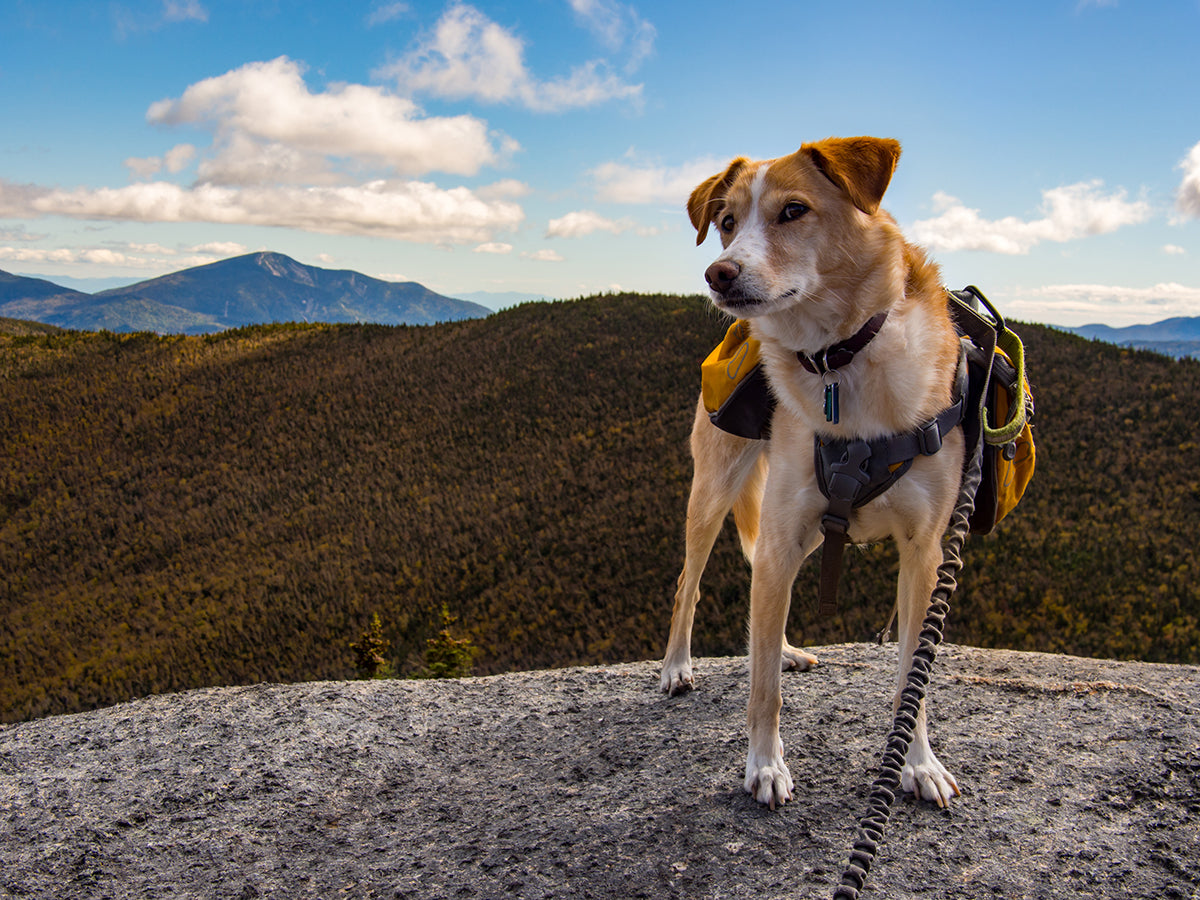The Ultimate Guide to Backpacking with Dogs

Backpacking with your dog is one of the most rewarding experiences you can have on the trail, allowing you to share a new adventure with your best friend.
Follow this guide to help you plan and execute a successful backpacking trip with your dog, ensuring both you and your pet enjoy a safe, memorable journey and lay the foundation for many hikes to come.
Planning Your Trip - Can & Should You Bring Your Dog?
Before you hit the trail, it's crucial to take a step back and set yourself, and your furry friend, up for success. First, assess whether your dog is suited for backpacking. Next, think critically about where you choose to go, starting small and working your way up to bigger trips.
Not all dogs are built for long hikes; consider your dog's age, breed, physical condition, and socialization/temperament. Breeds like huskies, border collies, and labrador retrievers tend to excel at endurance activities, while smaller or short-nosed breeds may struggle with the demands of the trail. This doesn’t mean your smaller dog won’t be a great hiker. You will just want to take some test hikes before your trip to make sure you are good to go.
Once you decide to take your dog backpacking with you, it's time to research some trails, and their regulations regarding dogs. Some trails and parks have restrictions or require permits for canine companions. Many do not, as long as they are on a leash. Look for dog-friendly trails with moderate terrain and accessible water sources. Finally, consider the climate and time of year, as extreme temperatures can pose serious risks to your dog.
Dog-friendly backpacking trails are:
- Smooth and not rocky
- Have available water sources
- Shady and not in direct sunlight
- Offer camping options at shorter distances
- 4-7 miles from the trailhead (this is a good starting distance! You can build from here!)

Gear & Packing
Just as you need specialized gear for backpacking, so does your dog. And just like a human, your dog should be able to carry its own gear. Here's our list of essential items:
- Dog Backpack/Vest: A well-fitted dog backpack allows your dog to carry its own food, water, and other essentials. Ensure the pack fits properly, is not overloaded, and does not weigh more than 5-15% of your dog’s bodyweight.
- Leash and Harness: A sturdy leash and harness are crucial for maintaining control and safety on the trail, rather than a standard collar. A hands-free leash can be particularly useful, just make sure your dog is comfortable hiking with it before you leave for multiple days.
- Collapsible Food and Water Bowls: Lightweight and easy to pack, collapsible bowls are perfect for on-the-go hydration and feeding. They can also clip onto the side of your or your dog’s pack for easy access. Dog Food: Pack enough dog food to keep your active pet happy. While you may consider dehydrated or freeze-dried options to save weight, like backpacking with kids, be certain your dog likes whatever food you bring on the trail.
- Water: Plan for your dog's hydration needs, bringing a filtration system for natural water sources.
- First Aid Kit: Include items like bandages, antiseptic wipes, tweezers, and paw balm. A canine-specific first aid kit is a great purchase due to its extensive wound care materials.
- Optional Booties: Protect your dog's paws from rough terrain and hot or cold surfaces with durable dog booties.
- Optional Sleeping Pad: A down quilt or an old sleeping pad makes a great dog bed if you don’t want to share.
Food and Water Planning
Proper nutrition and hydration are vital for your dog's health and stamina on the trail. Calculate the amount of food your dog will need based on the length and intensity of the trip. High-protein, high-fat foods are ideal for maintaining energy levels. Pack a little extra in case of emergencies or delays. Because all dogs and breeds are different (and can range from 5-100 lbs…) we recommend talking to your vet about food and water planning before going on your first backpacking trip with your dog.
Dogs are prone to dehydration, especially when exerting themselves, so plan for frequent water breaks. Giardia can affect a dog on trail, and risk passing on the infection to you. Even if your dog takes a few sips from a stream, you should fill its bowl with the same water you are drinking, either from a portable filter or a purification system. Read more here.

Training Your Dog for the Trail
Before embarking on a backpacking trip, your dog should be well-trained and accustomed to the trail environment. Basic obedience commands like "sit," "stay," "come," and "leave it" are essential for safety. Practice hiking with your dog on shorter, local trails to build their stamina and familiarize them with their gear.
Gradually increase the distance and difficulty of your hikes, observing how your dog handles different terrains and conditions. Socialize your dog with other hikers and dogs to ensure they behave appropriately in shared outdoor spaces. Train them with their gear, too! You don’t want to put their backpack on for the first time when you’re going backpacking.
Dog Trail Etiquette & Keeping Your Dog On-Leash While Hiking
Practicing good trail etiquette is crucial when backpacking with your dog. Always keep your dog on a leash, even if the trail permits off-leash hiking, to ensure their safety and prevent unwanted interactions with wildlife or other hikers. Remember, even if you can fully trust your dog, you cannot predict how other hikers, dogs, or wildlife will act. Respect wildlife by keeping your dog at a safe distance and preventing them from chasing or harassing animals.
While at camp, you can create a longer lead, but keep them safely on leash by stringing up a rope between two trees, and then attaching their leash to this rope. This gives them some more freedom but keeps them close.
Pick up after your dog and pack out all waste. The Pacific Crest Trail Association suggests burying dog poop like you would a human’s: in a 6-8-in hole far from the trail, campsite, and water sources. Even if you buy compostable poop bags, those take a very long time to break down, so we suggest still packing those out. Again, be aware of any specific rules regarding waste disposal for the area you will be hiking in.
Brush Up on Your Canine First Aid & Other Health and Safety Considerations
Accidents can happen, so being prepared with basic canine first aid knowledge is essential. Learn how to treat common injuries like cuts, scrapes, and sprains. Familiarize yourself with the signs of heatstroke, hypothermia, and dehydration, and know how to respond appropriately.
On trail, regularly check your dog for ticks, burrs, and other hazards that can hide in their fur. It’s good to stay in touch during the day, then do a thorough check at night before bed to check for ticks, but also for any tenderness, soreness or other injuries.
And if you haven’t been to the vet recently, it’s good to go for a checkup before your next trip. Keep up with vaccinations and ask your vet what additional preventive measures like flea, tick, and heartworm medications you should administer to your dog.

Campsite Setup and Sleeping Arrangements
When setting up camp, choose a site that provides some nice shade in the afternoon. Keep your dog close at night, either inside your tent or in its own secure, ventilated enclosure. This prevents them from wandering off and protects them from potential dangers like predators or extreme weather. No matter where your dog sleeps, note the sleeping pad or quilt we included on the gear list. Especially when the ground gets cold, your dog will be happy to have some padding.
Think about your own gear, too - if you’re sleeping in a tent with your dog, sharp nails can easily pop a fragile sleeping pad. Likewise, a two-person tent might be good for you and a partner, but what about you, a partner, and a dog? Testing your sleep setup at home will not only help your dog get comfortable with the tent, it will help make sure theat you have enough room for everyone to sleep comfortably.
Tips for a Successful Trip: Ensuring a Fun Time for Dogs and Humans
- Start Small: Begin with short, easy hikes to gauge your dog's abilities and gradually increase the difficulty.
- Monitor Your Dog's Health: The best preventative measure is to take breaks as needed. Pay attention to signs of fatigue, discomfort, or illness.
- Stay Flexible: Be prepared to adjust your plans based on your dog's needs and conditions on the trail. You don’t want to over-strain your dog, especially on the first day.
Pack your bags, leash up your dog, and hit the trail! With proper planning, training, and gear, your backpacking trip with your dog will be the first of many adventures to come.





